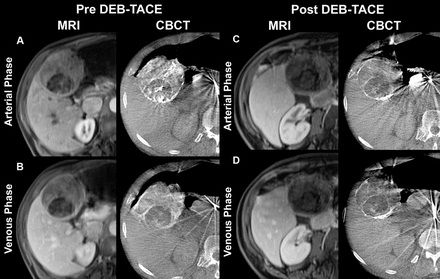Specialized CT Scans Detect Chemo Death of Liver Tumors
Pairs of specialized CT scans allow researchers to see liver tumors death right after chemo to quickly determine the efficacy of chemoembolization.
Using pairs of specialized CT scans researchers can observe the real-time death of liver tumors following injection of chemotherapy directly to the tumors and surrounding blood vessels, according to a study in the January issue of the journal Radiology. These images allow physicians to quickly determine the efficacy of chemoembolization, rather than having to wait months for evidence of results.
Researchers performed scans from March to December 2009 on 27 patients with inoperable liver cancer using an imaging technique developed at Johns Hopkins University called the dual-phase cone-bean computed tomography (DPCBCT).
These scans can be performed directly in the interventional radiology suite or wherever the patients are receiving treatment and is quick, with a total scanning time of 20 to 30 seconds. Radiation exposure from the dual scanning averages 3.08 milliseiverts, which is less than half the amount of radiation from an abdominal 64-slice CT scan, researchers said. The X-rays are detected with a laptop-sized device that can be placed directly below or above the operating room table. The scan has already has FDA approval for single-scan use.
To perform the DPCBCT scanning, a chemical contrast dye is injected into the artery that supplies blood flow to the liver and tumor right before the chemotherapy drug is injected. A first set of scans is performed to highlight key blood vessels and a second set is performed immediately after chemoembolization to gauge tumor and key blood vessel death. Computer software is used to sharpen and analyze differences between the images.
"This new scanning method is giving us almost instant feedback about the value of injecting antitumor drugs directly into large liver tumors and their surrounding blood vessels in an effort to quickly kill them, and to prevent the cancer from spreading," said senior study investigator and interventional radiologist Jean-Francois Geschwind, MD in a release. Geschwind is a professor in the Russell H. Morgan Department of Radiology at the Johns Hopkins University School of Medicine and its Kimmel Cancer Center.
The results showed that initial shrinkage seen with DPCBCT scans taken before and after chemoembolization matched up almost perfectly with MRI scans taken a month later. Tumor death was 95 percent, the same as that seen by MRI. A total of 47 tumors were closely monitored in the study to assess how well DPCBCT tracked tumor death after chemoembolization.
Improvements are needed to enhance image quality, Geschwind said. The researchers said they hoped further refinements will encourage physicians to adopt the technique. There are also plans to update navigational software, like GPS, that can track blood vessels feeding each tumor and provide more precise and greater numbers of targets.

Specialized DPCBCT scans of a liver tumor in a 73-year-old man before and after chemoembolization (second and fourth column from left) match up closely with MRI scans taken over a month later (first and third columns). Image courtesy Johns Hopkins University
Predicting Diabetes on CT Scans: What New Research Reveals with Pancreatic Imaging Biomarkers
March 25th 2025Attenuation-based biomarkers on computed tomography (CT) scans demonstrated a 93 percent interclass correlation coefficient (ICC) agreement across three pancreatic segmentation algorithms for predicting diabetes, according to a study involving over 9,700 patients.
The Reading Room: Racial and Ethnic Minorities, Cancer Screenings, and COVID-19
November 3rd 2020In this podcast episode, Dr. Shalom Kalnicki, from Montefiore and Albert Einstein College of Medicine, discusses the disparities minority patients face with cancer screenings and what can be done to increase access during the pandemic.